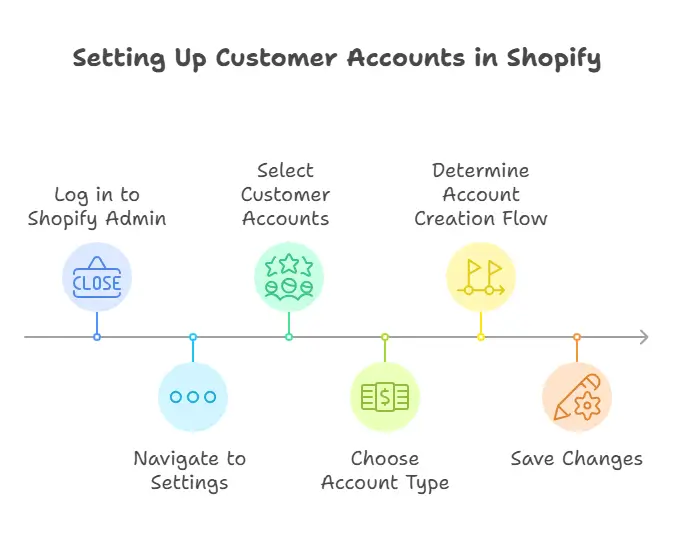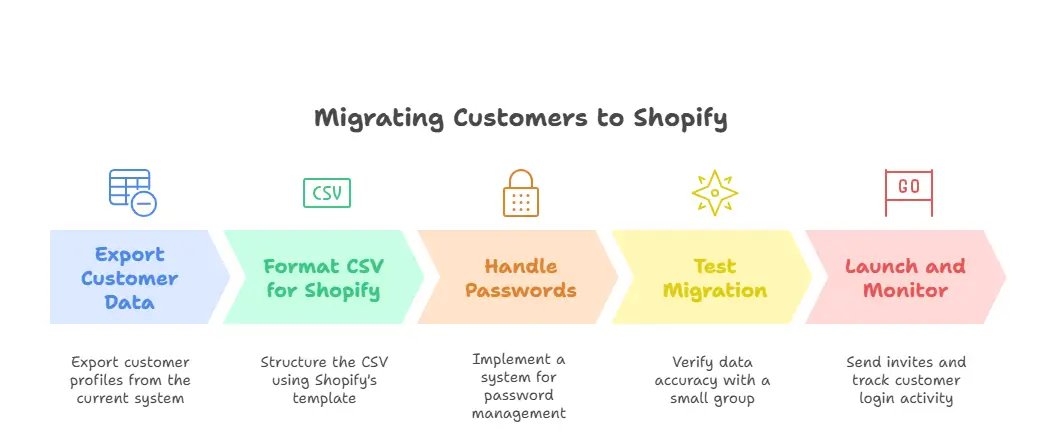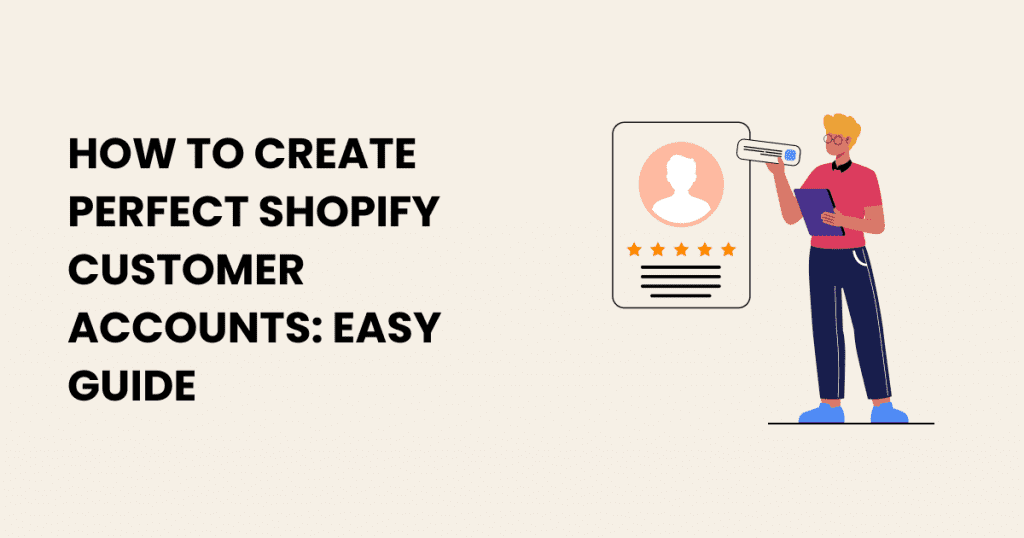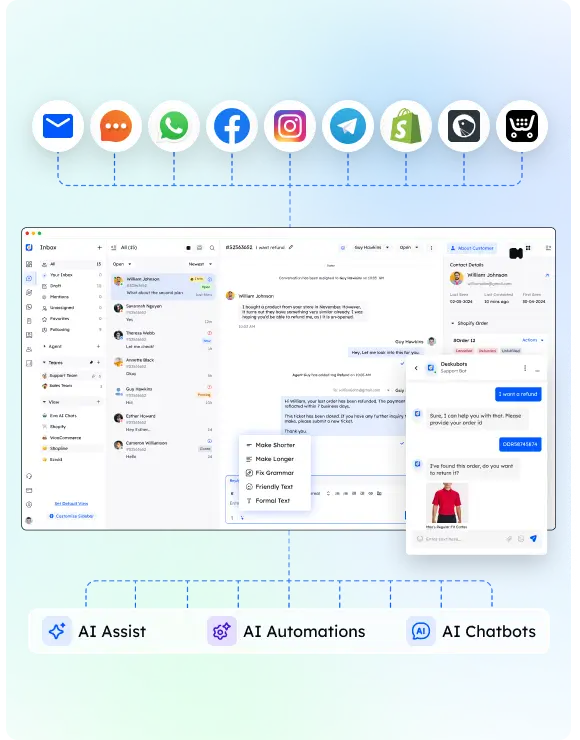Shopify customer accounts help stores boost repeat purchases, improve customer experience, and reduce support work. When enabled, customers can log in, view past orders, manage returns, save payment details, and more.
Shopify offers two types of customer accounts — classic and new. Choosing the right one is key to building a user-friendly experience that supports DTC growth, order management, and loyalty programs.
This guide shows you how to set up, customize, and improve customer accounts using Shopify features, APIs, and third-party apps — all while keeping your store’s branding and customer satisfaction top of mind.
Default Customer Account Types in Shopify: Explained
Shopify offers two types of customer accounts: classic and new. Each works differently and comes with its own benefits depending on what your ecommerce store needs.
Classic Customer Accounts
Classic accounts are the original Shopify customer accounts. They require a password and email for login. Customers can create an account using a basic Shopify customer login link. Once logged in, they can:
- View order history
- Update addresses
- Manage account info
Classic customer accounts live on a simple customer account page. It’s basic, but functional. You can customize the layout with Liquid customizations or apps, but deeper control is limited.
New Customer Accounts (Shopify)
Shopify new customer accounts offer a modern, smoother experience. Instead of a password, customers log in using a one-time verification code sent to their email. This reduces friction and improves the customer login process.
These new accounts are tied into Shopify’s customer account extensions, allowing developers to extend functionality with UI extensions, full page extensions, and embedded apps. You can build a full customer portal inside the account area — showing things like product bundles, loyalty points, store credits, and self-serve returns.
Shopify New Customer Accounts vs Classic
| Feature | Classic Accounts | New Customer Accounts |
|---|---|---|
| Login | Email + Password | One-time code |
| Customization | Basic Liquid edits | Full UI extensions |
| Apps Support | Limited | Supports customer account apps |
| Customer Experience | Basic | Modern, app-like |
| Ideal For | Simpler stores | Brands focused on UX and retention |
If you’re planning to build long-term customer satisfaction, offer self-service, and manage DTC customers at scale, the new customer accounts Shopify offers are a better fit. They’re also easier to maintain and update with developer preview tools.
Step-by-Step: How To Set Up Customer Accounts

Setting up customer accounts in Shopify is the foundation for building better relationships with your buyers. These accounts let users manage their orders, access account information, and use features like store credits or loyalty points. You can offer either classic accounts or new customer accounts, depending on your store’s needs.
Step 1: Log in to your Shopify Admin
Sign in to your Shopify admin panel using your store owner or staff account. Only users with proper permissions can change customer account settings.
Step 2: Go to Settings
Once inside your admin dashboard, scroll to the bottom left and click on Settings. This opens the global settings for your store.
Step 3: Click on Customer Accounts
In the Settings menu, find and click on the Customer accounts section. This is where you control how customer profiles and logins are handled.
Step 4: Choose Account Type – Classic or New
You’ll now see two account types:
- Classic customer accounts use the old email and password system. These are simple and still work for many businesses that want minimal setup.
- New customer accounts use a one-time code sent to the customer’s email. They offer a faster, more secure login flow and support app extensions like customer account UI extensions, self-serve options, and other tools to improve the customer account experience.
If you’re building for long-term growth, new customer accounts are easier to scale and offer a better experience overall.
Step 5: Choose Account Creation Flow – Optional or Required
You have control over how Shopify customers create their accounts:
- Optional: Customers can check out as guests or create an account if they want to. This reduces friction but may result in fewer logins.
- Required: All customers must create accounts to complete a purchase. This is useful for B2B stores or DTC brands that offer loyalty programs, store credits, or payment terms.
- Disabled: You can also choose to turn off customer accounts entirely.
Most stores that want more repeat customers should keep accounts optional and focus on improving the customer account interface.
Step 6: Save Changes
After selecting your account type and creation rules, scroll down and click Save. Your Shopify customer accounts setup is now live.
Customers will see a login link or create account option on the login page of your store. You can also manually send a Shopify customer login link via email or SMS.
Customizing the Customer Account Experience
Once customer accounts are enabled, the next step is to improve how they look and function. A good customer account page helps users manage their orders, update their info, and interact with your store without confusion. This is where many ecommerce brands stand out — by offering a smooth, branded, self-service experience.
There are three main ways to customize the Shopify customer account experience:
1. Theme Customization with Liquid (for Classic Accounts)
If you’re using classic customer accounts, you can adjust the look and feel using Shopify’s theme editor and Liquid templates.
You can:
- Change the layout of the customer login page
- Add store branding to the account page
- Show custom messages or order summaries
- Display customer tags or membership levels
Edits are made in the customer-related Liquid files, such as customers/login.liquid, customers/account.liquid, and others. You can also connect this to your order status page or include dynamic content using metafields.
2. Customer Account UI Extensions (for New Accounts)
If you’re using Shopify new customer accounts, the customization approach is different. Instead of editing Liquid files, you’ll use Shopify’s customer account extensions, which support embedded apps and full-page extensions.
This allows developers to build and deploy features like:
- Reorder buttons
- Product recommendations
- Loyalty programs and store credits
- Saved payment details and addresses
- Order history enhancements
These features live directly within the customer account interface and are designed for a more app-like experience. Everything looks native to your Shopify store and matches your merchant’s branding.
You can also use Shopify’s developer preview tools to test customer account extensions in your store before going live.
3. Connect with Third-Party Apps
Apps like Flits, CustomerHub, and ReConvert are designed to upgrade the Shopify customer account page. They offer plug-and-play features like:
- Self service returns
- Wishlist saving
- Loyalty point tracking
- Subscription management
- Personalized product bundles
These apps are ideal for teams that don’t have in-house developers but still want advanced features in their customer accounts Shopify section.
When choosing apps, make sure they support the new customer accounts Shopify offers — not all do. Many are still built for classic accounts.
Using Shopify APIs to Extend Customer Accounts
If your business needs more control over customer accounts, Shopify’s APIs give you what you need. These tools help developers build advanced features, connect third-party systems, and customize the customer experience beyond what’s possible in the admin.
Here’s how you can use Shopify APIs to improve customer accounts.
Storefront API
Shopify’s Storefront API gives developers access to customer data on the front end. You can build custom login pages, personalized dashboards, or full customer portals.
Use cases include:
- Showing a custom order index within the customer account
- Building account dashboards that display loyalty points or store credits
- Displaying subscription status, bundles, or past product views
The Storefront API is especially useful if you’re running a headless Shopify store or using frameworks like Hydrogen or Next.js.
Admin API
Shopify’s Admin API lets you manage customer data in the backend. It’s ideal for syncing customer profiles with CRMs, ERPs, or marketing platforms.
Examples of what you can do:
- Automatically tag customers based on order activity
- Update payment terms for B2B buyers
- Track customer satisfaction through notes and metadata
- Build rules for loyalty programs or VIP tiers
This helps reduce manual work and keeps your customer data clean and accurate.
Customer Account UI Extensions
With the new customer accounts setup, Shopify allows you to create UI extensions that live directly in the customer account area. These extensions let you:
- Add full-page experiences within customer accounts
- Pull in data from other apps (like order tracking or loyalty programs)
- Improve the account interface without rebuilding the whole store
These are useful for brands that want to provide a modern customer portal without going fully headless.
Customer Login and Authentication
You can also create custom login flows using Shopify’s Multipass login (for Shopify Plus stores). This allows external systems to authenticate users and log them into Shopify seamlessly. It’s useful for:
- SSO experiences
- Membership sites
- Integration with external identity providers
If you’re using the default setup, you can still create custom login links with parameters or track customers log activity through analytics tools.
Apps That Enhance Shopify Customer Accounts
Not every store has in-house developers. Even for teams that do, it often makes sense to use third-party apps to boost functionality inside the customer account section. Shopify’s app ecosystem includes several tools built to improve the customer experience, increase repeat purchases, and give buyers more control over their accounts.
Here are some of the most popular apps to upgrade your Shopify customer accounts:
Flits

Flits helps turn a basic account page into a full customer dashboard. It includes features like:
- Reorder button for past purchases
- Saved addresses and payment methods
- Wishlist tracking
- Loyalty programs
- Store credit options
Flits works with classic customer accounts. They’re also rolling out support for Shopify’s new customer accounts and UI extensions.
CustomerHub

CustomerHub is built for new Shopify customer accounts. It uses Shopify’s customer account extensions to offer:
- Embedded order tracking
- Quick login with one-time code
- Product recommendations inside the account page
- Custom tabs for subscriptions or bundles
This app integrates directly into the Shopify customer account interface without needing a full-page redirect or custom theme edits.
ReConvert

ReConvert is known for its post-purchase upsell features, but it also improves the order status page and account experience. It can:
- Show personalized offers within the account
- Let customers manage their product bundles
- Collect data about preferences and reorder behavior
This is helpful for stores that want to encourage more purchases after checkout without relying only on email.
Other Useful Apps
Each of these tools adds value within the customer account area or just outside it — often linking directly from the login page, order index, or navigation bar.
- Loop: Self-service returns and exchanges
- Rise.ai: Gift cards and loyalty rewards
- Okendo: Collect reviews from within the account
- Bold Subscriptions: Manage subscriptions inside customer accounts
Security Measures for Customer Accounts
Customer trust depends on how well you protect their data. Every Shopify customer account holds sensitive information — like order history, payment details, and contact data. Whether you’re managing 500 users or 500,000, securing customer accounts is non-negotiable.
Here’s how Shopify handles security, and what you can do to strengthen it further.
Shopify’s Built-in Security Features
Shopify includes several core protections by default:
- Encrypted data storage for customer profiles and payment info
- Secure checkout across all stores using HTTPS
- Fraud analysis tools on every order
- One-time verification code login for new customer accounts
- Strict API access controls and app review process
When you use new customer accounts Shopify, your customers don’t need to set a password. Instead, they receive a time-limited verification code via email. This lowers the risk of password-related breaches.
Classic customer accounts still rely on passwords, so it’s important to encourage strong password creation and monitor account activity for unusual login behavior.
Ways to Improve Security on Your Store
Even with Shopify’s protections, merchants and developers should take extra steps:
- Limit the number of apps with access to customer data
- Use Shopify’s admin permissions to control internal access
- Don’t store sensitive customer info in metafields or notes
- Use 2FA for all staff and admin users
- Avoid building login pages from scratch unless you fully control the code
If you’re on Shopify Plus, you also get access to Multipass login, which lets you connect your Shopify customer accounts with external identity systems. This is useful for companies with their own login systems or customer databases.
Compliance and Legal Considerations
Make sure your store complies with privacy laws like:
- GDPR (Europe)
- CCPA (California)
- PIPEDA (Canada)
- Others depending on your location
You may need to offer customers the ability to:
- Request their stored data
- Delete their account
- Update communication preferences
Shopify provides tools for data exports and deletion under the customer profile section in the admin.
If you’re collecting extra data within the customer account interface — like survey responses or loyalty status — make sure that data is handled according to these rules too.
Customer Trust Signals
You can also show customers they’re safe by:
- Displaying trust badges near the login and checkout areas
- Using clear language about how their data is stored
- Adding links to your privacy policy on account creation and login pages
- Using verified email addresses for transactional messages
Customers are more likely to create accounts and return to buy again if they know their data is secure.
How To Migrate Existing Customers to Shopify Without Friction

When moving to Shopify from another ecommerce platform, migrating customer accounts is a key part of a smooth transition. If done right, returning buyers won’t even notice the change. But if handled poorly, you risk login issues, support tickets, and lost sales.
Here’s how to migrate Shopify customer accounts the right way.
Step 1: Export Customer Data From Your Current Platform
Before anything else, export customer profiles from your current system. This usually includes:
- Full name
- Email address
- Phone number (optional)
- Shipping and billing addresses
- Tags or groupings
- Account creation date
- Last order date (if available)
If you’re coming from platforms like Magento, BigCommerce, or WooCommerce, most will offer CSV exports or direct integrations.
Be careful not to include sensitive data like passwords — Shopify doesn’t allow importing passwords for security reasons.
Step 2: Format Your CSV for Shopify
Use Shopify’s customer import CSV template to structure your file. Common fields include:
- First name / Last name
- Tags
- Address1 / Address2 / City / Country
- Phone
- Accepts marketing (yes/no)
If your existing platform tracks customer segments or B2B roles, you can use Shopify’s customer tags to replicate that behavior.
Once the file is ready, go to your Shopify admin → Customers → Import → Upload your CSV.
Step 3: Handle Passwords the Right Way
Here’s the catch — you can’t import customer passwords directly into Shopify.
That means customers will need to create accounts again using the email addresses they used before. You can make this simple by:
- Sending out a Shopify customer login link with a call to action like “Activate your account”
- Pre-filling email fields in the link
- Explaining why they’re being asked to log in again
If you’re using new customer accounts Shopify, the process is easier. Customers just enter their email and get a one-time code. No password needed. This significantly reduces friction and support requests.
Step 4: Test the Migration
Before inviting all customers to log in, test with a small group. Make sure:
- Data displays correctly in the customer account page
- Tags and addresses imported as expected
- Order history is connected (if migrated)
Note: Shopify doesn’t allow order data imports to connect directly to customer accounts unless you use the Shopify Plus Bulk Account Inviter or a private app. If order history matters, include it in your welcome messaging so customers know what to expect.
Step 5: Launch and Monitor
Once everything’s in place:
- Send personalized invites to different customer segments
- Use tracking tools to see who’s logging in
- Offer support via chat or email in case of login issues
- Remind customers of new features like self service returns, loyalty points, or subscription tools
You can also use apps that help streamline the invite process or offer perks for reactivating accounts.
Migrating customer accounts takes planning, but it’s worth the effort. Customers will appreciate a familiar, improved account interface and merchants will benefit from cleaner customer data inside their Shopify store.
Frequently Asked Questions (FAQ)
What are Shopify customer accounts?
Shopify customer accounts are profiles that let buyers log in to your store, view order history, save addresses, and manage preferences. These accounts make repeat purchases easier and give customers a self-service option.
What’s the difference between new customer accounts and classic accounts in Shopify?
Classic accounts use email and password. New customer accounts use a one-time verification code. The new version is more secure, works better with apps, and offers a modern interface using UI extensions.
How do customers create an account on Shopify?
Once customer accounts are enabled, buyers can create an account by clicking the login or create account link. If you’re using the new customer accounts system, they just enter their email and get a code to sign in.
Can customers see their past orders?
Yes. The account dashboard shows full order history, including products, totals, and status updates. Some stores add order tracking links or download options too.
Conclusion
Creating the perfect Shopify customer account system isn’t about flipping a switch. It’s about building a smooth experience that helps buyers come back, manage their info, and buy again with less friction.
For CTOs and engineers, Shopify offers the tools to build secure, scalable, and fully customizable account systems. For SMEs and enterprise teams, these accounts support loyalty programs, order tracking, self-service returns, and direct communication with your best customers.
Whether you go with classic or new customer accounts, the steps are clear:
- Set up the right account type
- Customize the interface to match your brand
- Use APIs or apps to expand functionality
- Migrate users cleanly if you’re switching platforms
- Manage your customer data actively and securely
The result? More repeat customers, fewer support tickets, better control over customer data, and a user-friendly experience that drives sales.
If your Shopify store serves B2B buyers, DTC customers, or both — getting customer accounts right is one of the most impactful things you can do.


